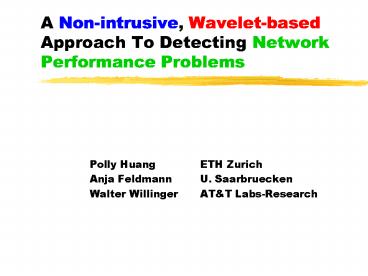A Non-intrusive, Wavelet-based Approach To Detecting Network Performance Problems - PowerPoint PPT Presentation
1 / 31
Title:
A Non-intrusive, Wavelet-based Approach To Detecting Network Performance Problems
Description:
A Non-intrusive, Wavelet-based Approach To Detecting Network Performance Problems Polly Huang ETH Zurich Anja Feldmann U. Saarbruecken Walter Willinger AT&T Labs-Research – PowerPoint PPT presentation
Number of Views:149
Avg rating:3.0/5.0
Title: A Non-intrusive, Wavelet-based Approach To Detecting Network Performance Problems
1
A Non-intrusive, Wavelet-based Approach To
Detecting Network Performance Problems
- Polly Huang ETH Zurich
- Anja Feldmann U. Saarbruecken
- Walter Willinger ATT Labs-Research
2
Road Map
- Motivation and rationale
- Mechanism details
- Conclusion and outlook
3
Performance Problem
Web
Web
TCP
TCP
Google.com
Internet
Network
Network
Link/Physical
Link/Physical
server
proxy
congestion
congestion
routing
routing
else
else
4
Current State
- Active probing
- Ex traceroute, ping
- Disturbing - injecting unnecessary traffic
- Biasing - distort metrics of interest
- Heisenberg effects
- Passive measurements
- Ex Cisco NetFlow, IP Accounting, other
packet-level measurment - give much information
- Do not infer problems inside the network
5
What Would Be Cool
- Passive
- Trigger alerts in real time
- For problems due to
- Server load
- Congestion
- Routing error
- Common Symptoms
- Delay and drop
6
TCPs Closed-loop Control
- Delays/drops reflected in RTT/RTO estimations
- RTT round trip time
- RTO retransmission timeout
- Quality of Network Path
- Values of RTT/RTO estimations
- Amounts of RTT/RTO samples
- Can be measured passively
7
Detailed Estimation
- Methodology
- A hash table of all data packets observed
- One RTT sample per data-ack pair
- One RTO sample per data-data pair
- Slow
- packets/observation period
- especially with high date rate connections (the
likely trouble makers)
8
Objectives
- Passive measurement
- Non-intrusive
- Infer quality of network paths
- Detecting network performance problem
- Efficiently (so can be done in real time)
- Wavelet-based technique
9
Road Map
- Motivation and rationale
- Mechanism details
- Conclusion and outlook
10
Wavelet-based Technique
- Theoretical ground
- Wavelet transform
- Energy plots (or scaling plots)
- Interpreting energy plots
- WIND, the problem detection tool
- Features examples
- Detection methodology
- Validation effort
11
Theoretical Ground
- FFT
- Frequency decomposition
- fj, Fourier coefficient
- Amount of the signal in frequency j
- WT wavelet transform
- Frequency (scale) and time decomposition
- dj,k, wavelet coefficient
- Amount of the signal in frequency j, time k
12
Wavelet Example
1
0
-1
00 00 00 00 11 11 11 11
s1 s2 s3 s4
d1 d2 d3 d4
13
Self-similarity
- Energy function
- Ej S(dj,k)2/Nj
- Self-similar process
- Ej 2j(2H-1) C lt- the magic!!
- log2 Ej (2H-1) j log2C
- linear relationship between log2 Ej and j
14
Self-similar Traffic
15
Effect of Periodicity
self-similar
Internet Traffic
16
Adding Periodicity
- packets arrive periodically, 1 pkt/23 msec
- coefficients cancel out at scale 4
17
Simulation TrafficSingle RTT
18
Simulation TrafficCongestion
19
Interpreting Energy Functions
- Abrupt knees at
- RTT time scale
- RTO time scale
- Knee shifts
- RTT/RTO time changes
- Low energy level (after normalization)
- congestion
- low traffic volume
20
WIND - The Detection Tool
- Wavelet-based
- Inference for
- Network
- Detection
- Based on libpcap and tcpdump
- On-line mode (efficient)
- Per packet compute dj,k
- Per observation period output Ej
- On a subnet basis
- Off-line mode
- Detailed RTT/RTO estimation
21
Real TrafficBy Subnets
22
Real TrafficBy Periods
23
Real TrafficBy Periods
24
Detecting Methodology
- Reference function
- Smoothed average
- Difference
- Area below the reference function
- Weighted sum by scale
- Flagged interesting
- Top 10 deviations
25
Pick Out Interesting Ones26, 30, 31
26
Validation By
- WIND off-line mode
- Detailed RTT/RTO estimations
- Volume
- Similar heuristics (area difference)
- CCDF of RTT/RTO
- Ratio of RTO/RTT
- Volume
27
Validate period 26, 30, 31
CCDF of RTO pick out period 23, 26, 31
CCDF of RTT pick out period 29, 30, 31
80-90 are validated interesting
28
Road Map
- Motivation and rationale
- Mechanism details
- Conclusion and outlook
29
Summary
- Detect problems using energy plots
- If self-similar, clean linear relationship
- If periodic, getting knees
- If problems, knee shifts or low energy level
- WIND the online/offline analysis tool
- Passive
- Efficient
30
Outlook
- Full-fledged diagnosing tool
- More sophisticated heuristics
- Use of traceroute data
- Illustrative examples
- Using the tool (beta release)
- Using the methodology
31
Questions?
- http//www.tik.ee.ethz.ch/huang





























